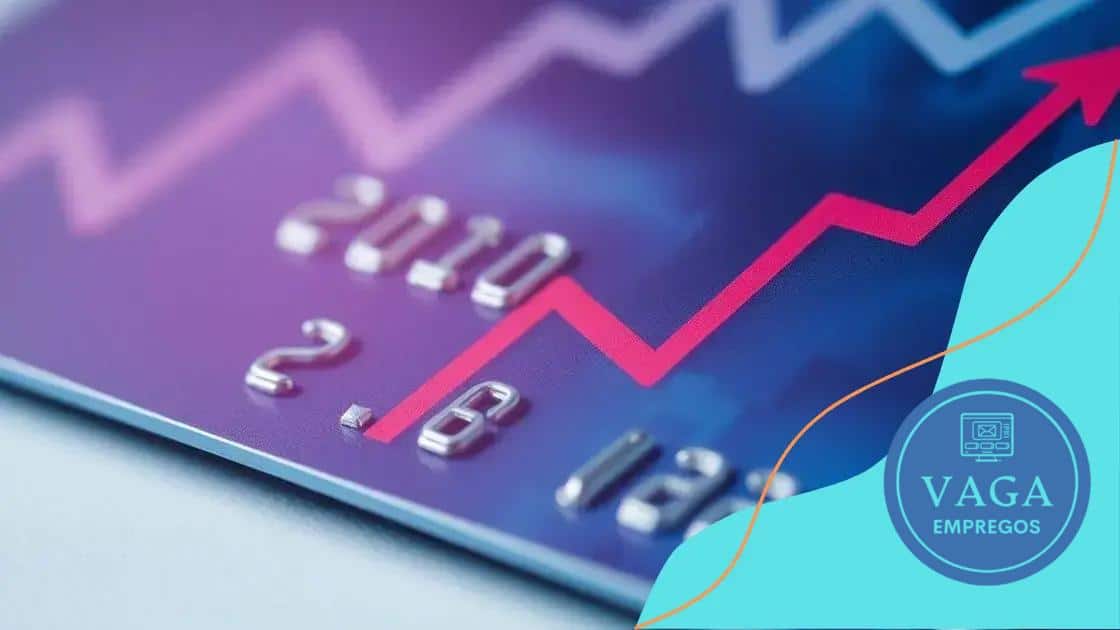Credit card interest rates reach all-time highs; explore why

Advertisement
Credit card interest rates are currently at all-time highs due to economic factors, inflation, and individual credit scores, significantly impacting consumer borrowing and spending habits.
Credit card interest rates reach all-time highs, making it more challenging for many to manage debt. Have you noticed how much it costs to carry a balance lately? Let’s explore the reasons behind these surging rates and what it means for you.
Advertisement
Understanding current credit card interest rates
Understanding current credit card interest rates is essential for effective financial management. With rates climbing, it’s important to know what influences these changes.
Advertisement
What are current interest rates?
Interest rates for credit cards can vary significantly. As of now, the average APR for credit cards is higher than it has been in years. This change affects consumers’ monthly payments and total debt.
How are interest rates determined?
Several factors contribute to determining interest rates:
- The economic climate plays a crucial role.
- Central bank policies can influence borrowing costs.
- Credit risk is evaluated through individual credit scores.
As the Fed adjusts rates to control inflation, credit card companies often follow suit. This can lead to higher costs for borrowing.
It’s also important to understand the difference between fixed and variable rates. Fixed rates remain consistent, while variable rates can change, often in relation to index rates.
Impact on borrowers
Higher rates mean that borrowing costs increase, which can lead to more debt if consumers carry a balance. Those with lower credit scores may face even steeper rates. It’s vital to stay informed and manage your credit wisely.
Considering the rise in credit card interest rates, many are exploring ways to minimize their financial exposure. Shop around for cards that offer better rates, and consider transferring balances to cards with lower introductory rates.
Factors driving interest rates up

Several factors driving interest rates up have a significant impact on consumers and the economy. Understanding these driving forces helps consumers navigate their financial decisions more effectively.
Economic conditions
The overall economic environment plays a crucial role. When the economy is strong, demand for credit rises, which can lead to increased rates. Conversely, during economic downturns, rates may drop to stimulate borrowing.
Inflation rates
Inflation is another key factor affecting interest rates. As prices rise, the purchasing power of money decreases. To keep pace with inflation, lenders increase rates. This helps protect their profits and ensures that they compensate for the reduced value of money over time.
- Higher inflation rates lead to increased borrowing costs.
- Lenders assess inflation risks when setting rates.
- Maintaining profitability is a priority for financial institutions.
Additionally, central banks, like the Federal Reserve, use interest rates as a tool to control inflation. By raising rates, they can cool down an overheating economy. This often results in more expensive credit card rates for consumers.
Credit risk and borrower profiles
Individuals’ credit scores also significantly influence the rates they receive. A higher credit score typically leads to lower interest rates. Lenders view this as a lower risk. Factors contributing to credit risk include payment history, credit utilization, and outstanding debt. If a borrower poses a higher risk, lenders respond with higher interest rates to protect themselves.
Understanding these variables can empower consumers to make informed choices. By knowing why rates are increasing, borrowers can better manage their credit and explore options such as refinancing or credit consolidation to alleviate the burden of high-interest debt.
Impact on consumers and borrowing habits
The impact on consumers and borrowing habits has become more pronounced as credit card interest rates rise. Higher rates lead to changes in how individuals manage their finances.
Changes in spending habits
When interest rates increase, consumers often shift their spending habits. Many begin to prioritize essential purchases over non-essentials. This shift can lead to decreased overall spending in the economy. Consumers are more cautious, avoiding taking on new debts when interest rates are high.
Increased reliance on credit
Some individuals may rely more on credit cards during financial difficulties. With rising costs of living, unexpected expenses can lead to increased credit card usage. This behavior can create a cycle of debt, as consumers find it harder to pay off their balances.
- Increased interest payments reduce available income.
- Consumers may turn to personal loans with fixed rates.
- Weighing options like balance transfers becomes common.
As consumers adapt to changing rates, they often seek ways to manage high-interest debt. Refinancing options or moving balances to cards with lower rates can provide some relief. Education about debt management becomes crucial during these times.
Additionally, individuals often reassess their budgets and financial plans. Many seek ways to reduce expenses, which can impact discretionary spending. In the long run, it’s important for consumers to stay informed about their financial health.
Strategies to manage high interest rates

Managing high interest rates effectively is essential for maintaining financial stability. There are several strategies to manage high interest rates that consumers can use to minimize their debt burdens.
Refinancing loans
One common strategy is refinancing existing loans. This process involves replacing a high-interest loan with a new one that has a lower rate. It can significantly reduce monthly payments and overall interest costs.
Balance transfer credit cards
Another popular option is to use balance transfer credit cards. These cards often offer low or zero introductory interest rates for a limited period. Transferring high-interest debt to these cards can provide temporary relief and make it easier to pay off balances.
- Look for cards with low or no balance transfer fees.
- Pay off the balance before the introductory period ends.
- Understand the regular interest rate that applies afterward.
In addition, diligently budgeting can help manage expenses more effectively. By closely tracking income and expenditures, consumers can identify areas to cut back and allocate more funds toward paying down debts. Creating a budget also encourages disciplined spending, reducing the risk of incurring more debt.
Building an emergency fund
Establishing an emergency fund is another effective strategy. Having savings set aside for unexpected expenses can help prevent relying on credit in times of need. This proactive approach ensures that individuals are better prepared for financial setbacks, allowing them to avoid high-interest debts.
Lastly, consumers should consider negotiating interest rates with their lenders. Sometimes a simple call to the bank can lead to lower rates, especially for long-standing customers. It’s worth exploring all possible avenues to manage high interest rates effectively.
Future trends in credit card interest rates
Understanding future trends in credit card interest rates helps consumers prepare for the financial landscape ahead. As economic conditions shift, predictions for rates can vary.
Expectations for interest rate changes
Experts anticipate that credit card interest rates may continue to rise due to factors such as inflation and central bank policies. When central banks tighten monetary policy, it often leads to higher rates across various lending products, including credit cards.
Technological advancements
As technology evolves, online lenders and fintech companies are changing the borrowing landscape. These companies often provide competitive rates and more flexible terms. This shift may lead traditional banks to reconsider their interest rates and attract more borrowers.
- The rise of financial technology can increase competition.
- Consumers may find better options online.
- Awareness of digital banking services is crucial.
Additionally, as consumers become more educated about their credit options, demand for transparency in rates could influence credit card companies. They may need to adopt clearer practices regarding how interest rates are determined and communicated.
Impact of consumer behavior
Future consumer behavior will also play a significant role in shaping interest rates. If more people prioritize paying down debt instead of accumulating it, lenders might respond by adjusting their rates. A shift toward financial literacy can create a demand for fairer terms.
As rates continue to evolve, staying informed about **credit card options** and market trends will be key for consumers. The landscape is likely to change, and being proactive may lead to better financial decisions in the future.
FAQ – Frequently Asked Questions about Credit Card Interest Rates
What factors influence credit card interest rates?
Credit card interest rates are influenced by economic conditions, inflation, and individual credit scores.
How can I manage high interest rates on my credit cards?
You can manage high interest rates by refinancing, transferring balances to lower-interest cards, and sticking to a strict budget.
Are there future trends in credit card interest rates I should be aware of?
Yes, trends show that rates may continue to rise due to inflation, and fintech companies are likely to create more competitive offers.
What should I do if I struggle with high credit card debt?
If you struggle with high credit card debt, consider creating a payment plan, seeking financial advice, or exploring debt consolidation options.





